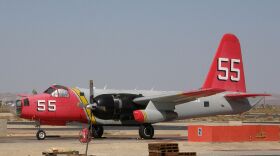Heavy firefighting air tankers are one of the most visible resources being used to fight the High Park Fire. The cost to fly and maintain the large aircraft is not cheap, and will continue to increase as the fire remains relatively uncontained.
These heavy air tankers – or just heavies as they are often referred to – can drop up to 2,100 gallons of retardant at a time. It’s one of the main reasons they’re in such demand.
Jennifer Jones with the National Interagency Fire Center in Boise, Idaho says as impressive as they are, tankers are not always used on every fire.
“You’re going to see a lot more air support typically during fires that are burning in areas near communities then fires burning in remote areas. So the percentage of costs on any individual fire that air support can account for can vary quite wildly depending on the fire.”
There are now five heavy air tankers fighting the High Park Fire. This is where things start to add up.
The current fleet of air tankers are not owned by the Forest Service, but are contracted by private companies like Neptune Aviation based in Missoula, Montana. Dan Snyder, president of Neptune says there are two ways the contracted planes are paid for by the government.
“The one is that we’re paid for the aircraft to be available by the US Forest Service to use as they need. Secondly, the agency will pay us for flight hours. And that flight hour purely depends on the activity of the season. Right now the aircraft are flying a lot, and so we’re paid for the hours that we fly. There will be times where the aircraft don’t fly at all, and we’re not paid dime one.”
Jones says it costs the Forest Service on average, $10,000 per day for a contracted heavy air tanker regardless if it’s sitting on the runway, or in the air. It costs an additional $5,000 to $6,000 per flight-hour depending on the type of tanker used.
Bill Hahnenberg, Type 1 incident commander of the High Park Fire says the Forest Service will spend between 30 and 40% of its allocated fire budget for air support over the duration of the blaze.
While that seems like a large amount of money, Jones says in the scheme of things, the total air tanker budget makes up a relatively small amount of the Forest Service’s annual 2 billion dollar firefighting fund -around 5%.
High Park Fire commanders say the majority of the nation's air tanker fleet will remain flying over the Northern Colorado fire, and will continue to do so until more areas of the blaze are contained; or unless they're needed somewhere else.







